[Editor’s Note: Mad Scientist is pleased to publish today’s post, exploring four possible near-term (i.e., 2020 to 2028) worlds facing us as we emerge from the COVID-19 Global Pandemic. Developed in support of a comprehensive TRADOC planning exercise this Summer, these worlds are illustrative of the near-term possibilities, rather than definitive. Indeed, the actual near term Operational Environment may consist of elements and aspects from all four of these postulated worlds. The TRADOC G-2 continues to work “hand-in-glove” with the Army Futures Command’s Intelligence and Security Directorate to define one consistent Operational Environment narrative, spanning the near, mid-, and far terms out to 2050. Read on to learn how the U.S. Army may be challenged in the coming decade!]
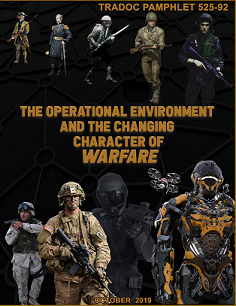 The COVID-19 pandemic arrived at an Operational Environment (OE) that already was moving in a direction in which our adversaries were making gains in terms of capabilities. As the United States was engaged in counter-insurgency operations in the Middle East and South Asia, our two pacing threats (Russia and China) studied our approaches to warfare, arrived at new conclusions on how to defeat the United States, and had started bringing into service new capabilities and skills that arguably created overmatch advantages in select areas. The effects of the pandemic will have implications on our ability to address these areas moving forward, particularly if difficult resource decisions need to be made between military modernization and enabling a broader domestic recovery. Under such circumstances, COVID-19 could be considered
The COVID-19 pandemic arrived at an Operational Environment (OE) that already was moving in a direction in which our adversaries were making gains in terms of capabilities. As the United States was engaged in counter-insurgency operations in the Middle East and South Asia, our two pacing threats (Russia and China) studied our approaches to warfare, arrived at new conclusions on how to defeat the United States, and had started bringing into service new capabilities and skills that arguably created overmatch advantages in select areas. The effects of the pandemic will have implications on our ability to address these areas moving forward, particularly if difficult resource decisions need to be made between military modernization and enabling a broader domestic recovery. Under such circumstances, COVID-19 could be considered  gasoline thrown on an already smoldering OE. This is represented by the horizontal axis in the figure below. On its left end we are looking at the OE that existed before pandemic; slowly evolving to new states braked by the normal resistance of organizations to dramatic change. On the right end we are talking about an OE with major disruptions to most of the operational environment’s variables and the demand for rapid adjustments to continue necessary functions and operations. These demands cause changes to the interactions and linkages among the OE variables at a dizzying pace, either by accelerating trends or implications for the OE or potentially even by slowing down progress and creating bottlenecks or brakes which disrupt the OE. They impact organizations like the U.S. Army, whose processes and structure are built around a definitive culture and age-old traditions.
gasoline thrown on an already smoldering OE. This is represented by the horizontal axis in the figure below. On its left end we are looking at the OE that existed before pandemic; slowly evolving to new states braked by the normal resistance of organizations to dramatic change. On the right end we are talking about an OE with major disruptions to most of the operational environment’s variables and the demand for rapid adjustments to continue necessary functions and operations. These demands cause changes to the interactions and linkages among the OE variables at a dizzying pace, either by accelerating trends or implications for the OE or potentially even by slowing down progress and creating bottlenecks or brakes which disrupt the OE. They impact organizations like the U.S. Army, whose processes and structure are built around a definitive culture and age-old traditions.
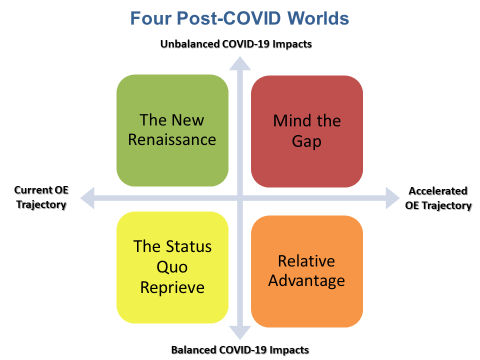
The impact of the pandemic on the competition that exists between the great powers is the second driver. As the saying goes, the enemy gets a vote. This analysis must also include an understanding on how COVID-19 impacts the United States in comparison with our pacing threats if we are to more fully understand the impact of the pandemic on the Army. This driver is represented by the vertical axis of the quad chart. On the lower end, the impact—considered largely in terms of DIME effects—is relatively balanced, with no one side accruing significant advantages in terms of global competition. The effect is uneven on the upper end with one side or another gaining significant competitive advantages. It is likely that the effects of the  pandemic, particularly in the medium-to-long term, will fall relatively evenly among the United States and its two primary adversaries, China and Russia. However, while we expect that the overall effects will be balanced, it is highly likely that Chinese and Russian public sector technology investment and defense spending—including military modernization—will suffer far less than in the U.S. and its Western allies. China’s and Russia’s centralization of authority and their focus on security over individual liberty enable these adversaries to maintain their current priorities without having to be responsive to their respective publics by diverting resources to a general recovery.
pandemic, particularly in the medium-to-long term, will fall relatively evenly among the United States and its two primary adversaries, China and Russia. However, while we expect that the overall effects will be balanced, it is highly likely that Chinese and Russian public sector technology investment and defense spending—including military modernization—will suffer far less than in the U.S. and its Western allies. China’s and Russia’s centralization of authority and their focus on security over individual liberty enable these adversaries to maintain their current priorities without having to be responsive to their respective publics by diverting resources to a general recovery.
When considered together, these two drivers create four worlds that represent alternative futures marked by the interrelationship between the COVID-influenced OE and its relative impact on the United States, China, and Russia.
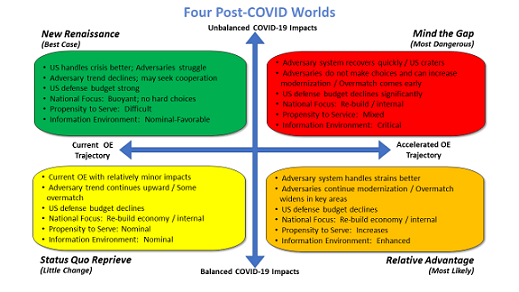
The Status Quo Reprieve (Lower left quadrant and Little Change)
This world represents the world and OE essentially as we had assessed it prior to the COVID-19 pandemic, with some small exceptions. It assumes that the impact of COVID-19 is relatively balanced between the United States and its pacing threats so that there are no great system altering changes that occur. 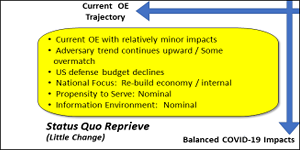 Our adversaries grow in capabilities at the same pace relative to the United States as has been previously assessed, although with some delays on certain systems, capabilities, technologies, or concept/doctrine development. In essence, our adversaries will continue to develop their forces so that they will achieve selective overmatch in some capabilities and technologies by 2025-2028.
Our adversaries grow in capabilities at the same pace relative to the United States as has been previously assessed, although with some delays on certain systems, capabilities, technologies, or concept/doctrine development. In essence, our adversaries will continue to develop their forces so that they will achieve selective overmatch in some capabilities and technologies by 2025-2028.
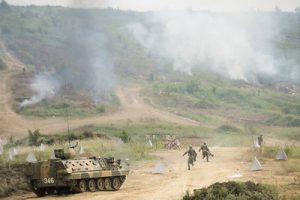
The United States likely will retain an overall military advantage, primarily because the Joint force will still have advantages in integrating capabilities and in human capital, even if some of adversaries’ weapon systems may be superior to our own. This advantage, however, will lessen by 2028 as our adversaries work on their own advanced training and education efforts and develop and practice new concepts and doctrine. Our adversaries will remain increasingly active in the competition space as they sense opportunity in this below-armed-conflict realm. While open conflict between great powers remains relatively unlikely, the chance for miscalculation may be heightened. COVID-19 will not change the fundamental nature of DIME as the toolbox for national strategy. It will, however, offer possibilities for unexpected shifts in national, regional, and global relationships.
One of the most notable changes will be that virtual communications will be a common part of everyday life. With vast segments of the nation working from home and so much social activity reliant on online communications (Zoom, Skype, Hangouts, Teams, etc.), business practices and traditional ways of communicating will be altered and new norms will be established. Internally, the already stratifying divisions that have occurred in terms of political outlook, social views, and debate between collective security and individual liberty will continue and be intensified to some degree by reaction to the pandemic (e.g., disputes over social distancing, wearing masks, the tradeoff between personal control of private information and its collection for public welfare, the tradeoff between public health and economic health, etc.).
As the Government focuses on rebuilding the economy, the DOD and Army likely will face budget reductions, although in this scenario the reductions are not terribly severe and certainly are less than anticipated. Some plans will nevertheless impact both Army readiness and modernization. Modernization 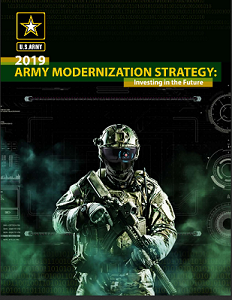 may be slightly delayed that will in turn somewhat impact the Army’s training and education budget. Although the influence of COVID-19 will be relatively limited on the economy as a whole, there will be both geographical and market-sector pockets that will face challenges. The Army may as a result be presented with opportunities in terms of recruiting new personnel. Conversely, while the Army may offer a significant opportunity for those impacted by COVID-19, it will have to compete not only with other services but with industries that were publicly on the front lines of the COVID response, including the medical profession, first responders, science and technology researchers, and information technology providers.
may be slightly delayed that will in turn somewhat impact the Army’s training and education budget. Although the influence of COVID-19 will be relatively limited on the economy as a whole, there will be both geographical and market-sector pockets that will face challenges. The Army may as a result be presented with opportunities in terms of recruiting new personnel. Conversely, while the Army may offer a significant opportunity for those impacted by COVID-19, it will have to compete not only with other services but with industries that were publicly on the front lines of the COVID response, including the medical profession, first responders, science and technology researchers, and information technology providers.

Relative Advantage (lower right quadrant and Most Likely)
This world represents a departure from the assessed OE and assumes that the impacts of the COVID-19 pandemic are not as severe or system altering as initially feared, but that the United States (and its Western allies) are less able to handle the stresses and shocks imposed by the pandemic when compared 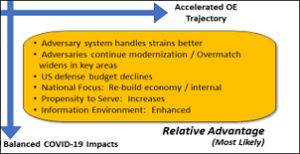 to the centralized systems of our key pacing threats. While there is greater balance in the impacts and stresses on the U.S. and our adversaries’ abilities to act than in the Mind the Gap (Worst case) world, the consequences do not fall equally on all. In this world, however, our adversaries are better able to keep a focus on readiness and military modernization due to their ability to prioritize defense and security issues over the reconstruction of the civilian economy. As a result, our adversaries’ modernization efforts will continue to outpace our own, and in some ways, will expand the gaps that already were developing in the pre-COVID-19 OE. Some of their more advanced capabilities may enter service either quicker than our own or on schedule whereas most U.S. efforts are delayed.
to the centralized systems of our key pacing threats. While there is greater balance in the impacts and stresses on the U.S. and our adversaries’ abilities to act than in the Mind the Gap (Worst case) world, the consequences do not fall equally on all. In this world, however, our adversaries are better able to keep a focus on readiness and military modernization due to their ability to prioritize defense and security issues over the reconstruction of the civilian economy. As a result, our adversaries’ modernization efforts will continue to outpace our own, and in some ways, will expand the gaps that already were developing in the pre-COVID-19 OE. Some of their more advanced capabilities may enter service either quicker than our own or on schedule whereas most U.S. efforts are delayed.
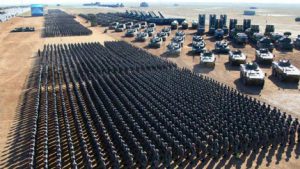
This will create significant challenges for the Joint force and Army as our adversaries accelerate their own capabilities and develop overmatch in key areas more rapidly or at relative advantage to the United States. The previously assessed land combat gaps will widen in select areas as our adversaries (at least China) start to outpace the United States more quickly in terms of overall capability than anticipated. Adversaries could develop true overmatch as early as 2023 in some key areas, particularly if anticipated U.S. capabilities are delayed or cancelled. Additionally, our adversaries almost certainly will understand the relative advantages they are creating. They could become more activist as a result, particularly in the competition space. In some cases, this effort could be undertaken right up to the point of conflict to secure their national objectives. The United States will retain critical advantages, particularly in terms of human capital, experience, and in the ability to conduct Joint operations, but these will lessen as our adversaries continue their own efforts to improve.
The economic recovery within the United States in this scenario raises problems. Overall budgetary reductions to DOD will be relatively limited but will not allow us to keep pace with gains by Beijing and perhaps Moscow. As a result, DOD and the Army will have to make hard choices between readiness and modernization that could become even more difficult if adversaries begin to flex their growing muscles. The hard choices that need to be made will also be impacted by the economic needs of the nation. This means that materiel  solutions—which provide jobs to many Americans—may take precedence over readiness, requiring some creativity to ensure that other areas of importance across the DOTMLPF are not left to wither.
solutions—which provide jobs to many Americans—may take precedence over readiness, requiring some creativity to ensure that other areas of importance across the DOTMLPF are not left to wither.
The same focus on high-tech/online communications and collaboration tools will be in effect here as the American populace becomes more attuned to the virtual world. Internal divisions will continue, placing further stresses on the DOD budget as politicians grapple with the need to jump-start the economy. Although this does not represent a worst-case scenario, many segments of the population—based on region, class, and industry—will face very real challenges. These in turn could present opportunities for Army recruiting. The Army will, however, face challenges in terms of competing for talent with newfound or newly popular lines of work, including the medical field, biotechnological research, first responders, and IT.
A New Renaissance (upper left quadrant and Best Case)
This world represents an unlikely best-case scenario in which there is an unbalanced impact of COVID-19 across our pacing threats, but one dramatically favoring the United States. The United States becomes the post-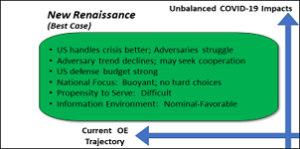 COVID-19 world leader. The centralized systems of China and Russia do not keep pace in terms of innovation and development and delivery of medicines and vaccines that mitigate the virus. Global supply chains and investment shift away from China as countries seek greater diversity in sourcing, slowing China’s economic expansion and technological development. Furthermore, the initial shocks of the COVID-19 virus to the U.S. economy are reduced in a wave of optimism that follows the rapid introduction of medicines that counter the disease.
COVID-19 world leader. The centralized systems of China and Russia do not keep pace in terms of innovation and development and delivery of medicines and vaccines that mitigate the virus. Global supply chains and investment shift away from China as countries seek greater diversity in sourcing, slowing China’s economic expansion and technological development. Furthermore, the initial shocks of the COVID-19 virus to the U.S. economy are reduced in a wave of optimism that follows the rapid introduction of medicines that counter the disease.
The nation rallies together in a newfound wave of cooperation not seen since the early days after 9/11 or even in the dark days of World War II. The common  good prevails and the nation takes off, leaving behind in the distance our pacing threats, who become reliant on the United States and the West for the medical capabilities to combat the disease and its successors. As a result, DOD budgets are not impacted in any meaningful way and in some cases may even advance (particularly in terms of military medicine, CBRN defense, biotechnology, and information technology). Our adversaries’ military modernization efforts lag; the United States is therefore able to remain comfortably ahead through 2028. China and Russia will only be able to get back on track toward the end of the period (2025 at the earliest, 2028 or later more likely).
good prevails and the nation takes off, leaving behind in the distance our pacing threats, who become reliant on the United States and the West for the medical capabilities to combat the disease and its successors. As a result, DOD budgets are not impacted in any meaningful way and in some cases may even advance (particularly in terms of military medicine, CBRN defense, biotechnology, and information technology). Our adversaries’ military modernization efforts lag; the United States is therefore able to remain comfortably ahead through 2028. China and Russia will only be able to get back on track toward the end of the period (2025 at the earliest, 2028 or later more likely).
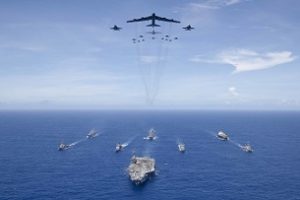 The outright advantages accrued to the United States could lead to broader global cooperation, including a stronger U.S.-led alliance in the Indo-Pacific to contain China’s ambitions and, in some cases, U.S. collaboration with China and Russia. The U.S. military would be spared the hard choices between readiness, force structure, and modernization. Yet these new OE realities will have a significant impact on the Army. The drive toward the virtual world will continue to accelerate. New business practices forged during the pandemic will increasingly take root. Previous divisions within the nation will grow smaller, with the vast majority of the population enjoying the benefits of the newfound optimism, collaborative spirit, and focus on the common good. A new focus on science, technology, and the objective world will make the nation more resilient in the face of our adversaries’ information capabilities.
The outright advantages accrued to the United States could lead to broader global cooperation, including a stronger U.S.-led alliance in the Indo-Pacific to contain China’s ambitions and, in some cases, U.S. collaboration with China and Russia. The U.S. military would be spared the hard choices between readiness, force structure, and modernization. Yet these new OE realities will have a significant impact on the Army. The drive toward the virtual world will continue to accelerate. New business practices forged during the pandemic will increasingly take root. Previous divisions within the nation will grow smaller, with the vast majority of the population enjoying the benefits of the newfound optimism, collaborative spirit, and focus on the common good. A new focus on science, technology, and the objective world will make the nation more resilient in the face of our adversaries’ information capabilities.
Although defense budgets will be relatively untouched, DOD and the Army will nevertheless still face some significant challenges. The most critical will be in the human capital world. With the economy taking off and new businesses, industries, and opportunities arising quickly, the Army will be forced into an even deeper competition for human capital. The Army will have to be very creative in demonstrating the type of opportunities it offers and may require 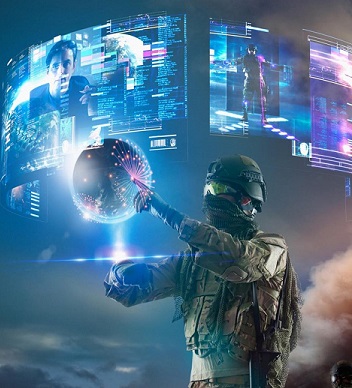 rethinking some of its long-held beliefs and practices. As part of this, the Army will need to consider what it offers potential recruits in terms of access to high technology, virtual opportunities, and world-class installations that offer as much in terms of living conditions, recreation opportunities, access to information technology, and training and education opportunities as competitors for the workforce. The Army will be competing with high-tech industry, the medical field, information technology fields, and the best universities in the nation. It will therefore need to rethink how it recruits, trains, educates, and houses its troops. Installations, for example, may need to look more like university campuses or professional sports training complexes. Additionally, the Army may need to think about additional flexibility in how Soldiers serve to be more in line with developments in the civilian world.
rethinking some of its long-held beliefs and practices. As part of this, the Army will need to consider what it offers potential recruits in terms of access to high technology, virtual opportunities, and world-class installations that offer as much in terms of living conditions, recreation opportunities, access to information technology, and training and education opportunities as competitors for the workforce. The Army will be competing with high-tech industry, the medical field, information technology fields, and the best universities in the nation. It will therefore need to rethink how it recruits, trains, educates, and houses its troops. Installations, for example, may need to look more like university campuses or professional sports training complexes. Additionally, the Army may need to think about additional flexibility in how Soldiers serve to be more in line with developments in the civilian world.
Mind the Gap (upper right quadrant and Most Dangerous)
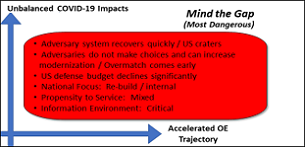 This world represents a clear worst-case scenario in which the COVID-19 pandemic implications are unbalanced in favor of our adversaries. The U.S. economy is savaged by the pandemic and the recovery takes more than a decade. DOD budgets will face severe pressures, challenging both readiness and modernization simultaneously. Conversely, nations with centralized
This world represents a clear worst-case scenario in which the COVID-19 pandemic implications are unbalanced in favor of our adversaries. The U.S. economy is savaged by the pandemic and the recovery takes more than a decade. DOD budgets will face severe pressures, challenging both readiness and modernization simultaneously. Conversely, nations with centralized 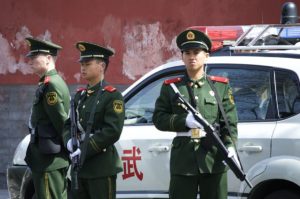 decision-making processes and societies that tend to focus on security over individual liberty are able to weather the storm posed by COVID-19, thrive, and even prosper. The net result is a significant advantage that accelerates their modernization efforts in comparison with the flat-lining United States and widens overmatch/reduces U.S. advantages in key areas much quicker than initially anticipated. The United States will be compelled to turn inward to deal with faltering economic progress and widespread divisions within an increasingly restive society.
decision-making processes and societies that tend to focus on security over individual liberty are able to weather the storm posed by COVID-19, thrive, and even prosper. The net result is a significant advantage that accelerates their modernization efforts in comparison with the flat-lining United States and widens overmatch/reduces U.S. advantages in key areas much quicker than initially anticipated. The United States will be compelled to turn inward to deal with faltering economic progress and widespread divisions within an increasingly restive society.
 Our adversaries will take advantage of this situation in several ways. First, they will further increase their information campaigns against the United States to reinforce societal divisions and create rifts between and within the population and with U.S. allies. Second, as they quickly grasp the disadvantaged position into which the United States is falling, they will become more active in pursuing their own national goals and use all elements of the DIME to demonstrate to the world their rise in the face of a U.S. retreat. Third, they will become more aggressive in the competition space to further the American turn inward and compel regional states to accede to their wishes. This will largely focus on issues short of war; in some cases this will involve threats of military force, armed demonstrations, and perhaps combat. At a minimum, the chance of conflict increases as our adversaries see new freedom of action.
Our adversaries will take advantage of this situation in several ways. First, they will further increase their information campaigns against the United States to reinforce societal divisions and create rifts between and within the population and with U.S. allies. Second, as they quickly grasp the disadvantaged position into which the United States is falling, they will become more active in pursuing their own national goals and use all elements of the DIME to demonstrate to the world their rise in the face of a U.S. retreat. Third, they will become more aggressive in the competition space to further the American turn inward and compel regional states to accede to their wishes. This will largely focus on issues short of war; in some cases this will involve threats of military force, armed demonstrations, and perhaps combat. At a minimum, the chance of conflict increases as our adversaries see new freedom of action.
U.S. societal divisions will make it difficult for the nation to recover from the COVID-19-inspired decline as it will be difficult to agree on ways forward. The DOD budget will suffer dramatically, even in the face of renewed threats, as taxpayer dollars are redirected to jump-start the economy. Information technology, the medical sector, and other technological fields will be at the forefront of bringing the nation out of the morass, but it will take time. In 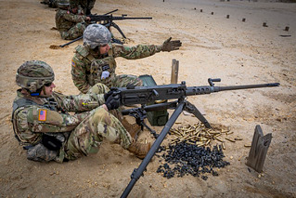 essence, DOD and the Army will need to make do with the capabilities that exist today. These include difficult trade-offs between force structure, readiness, and modernization through 2028 and beyond. Additionally, it will be increasingly difficult for our military to consistently retain an overseas presence. The military’s numbers may decline as a result of the budgetary cuts; yet the Army will likely be able to take advantage of a weakening
essence, DOD and the Army will need to make do with the capabilities that exist today. These include difficult trade-offs between force structure, readiness, and modernization through 2028 and beyond. Additionally, it will be increasingly difficult for our military to consistently retain an overseas presence. The military’s numbers may decline as a result of the budgetary cuts; yet the Army will likely be able to take advantage of a weakening 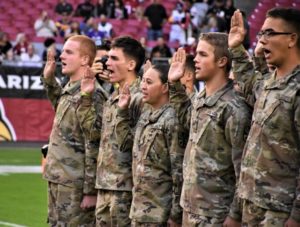 economy to recruit high-quality new personnel. Indeed, human capital may be our best investment in such a situation, possibly acting as a hedge against our adversaries and a springboard for modernization, although this likely will be after 2028. Training and education will suffer, but creative approaches, particularly in distance learning and virtual education, may provide advantages. The United States will be in an increasingly difficult position through 2028 and beyond. Laying the ground work for a new kind of force that would mature in the mid-to-late 2030s may become necessary.
economy to recruit high-quality new personnel. Indeed, human capital may be our best investment in such a situation, possibly acting as a hedge against our adversaries and a springboard for modernization, although this likely will be after 2028. Training and education will suffer, but creative approaches, particularly in distance learning and virtual education, may provide advantages. The United States will be in an increasingly difficult position through 2028 and beyond. Laying the ground work for a new kind of force that would mature in the mid-to-late 2030s may become necessary.
To learn more about the OE, watch the following two videos:
-
-
- The TRADOC G-2’s new “The 2 + 3 Threat” — addressing the near term OE.
-
-
-
- The Army Future Command’s new “Forging the Future in an Uncertain World” — addressing the mid-to-far term OE.
-
If you enjoyed today’s post, check out each of the following ones from our Contagion: COVID-19’s impact on the Operational Environment series:
… as well as the following related posts:
-
-
- Persistent Disorder Strikes Back – Implications for Future Joint Force Design, by proclaimed Mad Scientist Jeff Becker
-
- Disclaimer: The views expressed in this blog post do not necessarily reflect those of the Department of Defense, Department of the Army, Army Futures Command (AFC), or Training and Doctrine Command (TRADOC).




It’s gonna be hard for the US but the country will have to learn dialogue and diplomacy. In most cases, military action won’t be a viable option anymore. This is how it goes. The world changes, evolves…